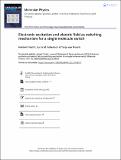Files in this item
Electronic excitation and electric field as switching mechanism for a single-molecule switch
Item metadata
| dc.contributor.author | Früchtl, Herbert | |
| dc.contributor.author | Robertson, Lorna M. | |
| dc.contributor.author | van Mourik, Tanja | |
| dc.date.accessioned | 2022-08-10T15:30:32Z | |
| dc.date.available | 2022-08-10T15:30:32Z | |
| dc.date.issued | 2022-08-06 | |
| dc.identifier | 280687525 | |
| dc.identifier | 074978ec-c01e-46f9-af94-25cbc64caa19 | |
| dc.identifier | 000837153600001 | |
| dc.identifier | 85136801541 | |
| dc.identifier.citation | Früchtl , H , Robertson , L M & van Mourik , T 2022 , ' Electronic excitation and electric field as switching mechanism for a single-molecule switch ' , Molecular Physics , vol. Latest Articles , e2108517 . https://doi.org/10.1080/00268976.2022.2108517 | en |
| dc.identifier.issn | 0026-8976 | |
| dc.identifier.other | ORCID: /0000-0001-6647-4266/work/117211012 | |
| dc.identifier.other | ORCID: /0000-0001-7683-3293/work/117211258 | |
| dc.identifier.uri | https://hdl.handle.net/10023/25815 | |
| dc.description.abstract | DFT calculations show that a combination of an electric field and electronic excitation is a promising mechanism to force a molecular switch based on amino-imino tautomerisation into one of its two states. By calculating the effect of an electric field in the direction of the moving hydrogen on the shape of the barrier in the ground and low-lying excited states of previously proposed molecular switches consisting of 5- and 7-membered rings with adjacent amino and imino groups, we demonstrate that electric fields and photons in experimentally accessible ranges introduce sufficient asymmetry to push the switch into the desired configuration. Excitation to states with inverted order of the preferred geometry allows reversible switching without reversal of the electric field. | |
| dc.format.extent | 2210621 | |
| dc.language.iso | eng | |
| dc.relation.ispartof | Molecular Physics | en |
| dc.subject | Molecular switch | en |
| dc.subject | Excited states | en |
| dc.subject | Electric field | en |
| dc.subject | Density functional theory | en |
| dc.subject | Molecular electronics | en |
| dc.subject | QD Chemistry | en |
| dc.subject | DAS | en |
| dc.subject.lcc | QD | en |
| dc.title | Electronic excitation and electric field as switching mechanism for a single-molecule switch | en |
| dc.type | Journal article | en |
| dc.contributor.institution | University of St Andrews. School of Chemistry | en |
| dc.contributor.institution | University of St Andrews. Centre for Research into Equality, Diversity & Inclusion | en |
| dc.contributor.institution | University of St Andrews. EaSTCHEM | en |
| dc.identifier.doi | 10.1080/00268976.2022.2108517 | |
| dc.description.status | Peer reviewed | en |
This item appears in the following Collection(s)
Items in the St Andrews Research Repository are protected by copyright, with all rights reserved, unless otherwise indicated.

